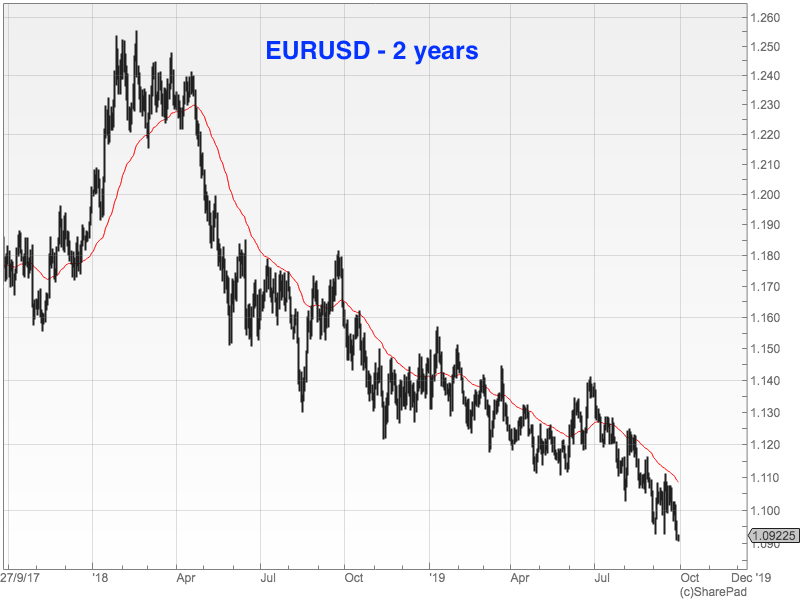Currency Corner: how low can the euro go?
Dominic Frisby looks at the world’s two biggest currencies – the US dollar and the euro – and picks three clear targets for traders as the euro continues to slide.


In today's Currency Corner, I thought I'd take another currency pair at random, and see what's what.
Rather than the obscure or the exotic, let's stick with the mainstream and go for the world's two biggest currencies the US dollar and the euro.
The world's reserve currency and also the world's most traded currency, the dollar is held by pretty much every central bank in the world. It is accepted wherever you go. It is not just the currency of the US, but effectively of the many countries that peg their currency to it.
MoneyWeek
Subscribe to MoneyWeek today and get your first six magazine issues absolutely FREE

Sign up to Money Morning
Don't miss the latest investment and personal finances news, market analysis, plus money-saving tips with our free twice-daily newsletter
Don't miss the latest investment and personal finances news, market analysis, plus money-saving tips with our free twice-daily newsletter
It is also the standard by which many commodities are valued from oil to wheat to gold and their prices will often move, not because of any change in their fundamentals, but simply because the US dollar is moving.
Despite being only 20 years old, the euro is the world's second-most traded currency and its second-largest reserve currency. It is also widely pegged to, especially in Africa. It is often seen as a proxy for European economic health and, as the currency of so many different European nations with different needs and circumstances, it is heavily politicised and the subject of many a political argument.
The EUR/USD pair then, is the most traded and the most valuable pair in forex: the biggest pair in the biggest market in the world. Kind of important.
Trading this pair is known as trading the euro, especially in North America, and the pair is quoted as how many US dollars it takes to buy a euro. For example, today the price is $1.09. It takes one dollar and nine cents to buy a euro.
Below there's a chart of EUR/USD since the euro's inception 20 years ago. When the chart is rising the euro is strengthening and the US dollar is weakening. When the chart is falling, the reverse applies: the euro is getting weaker and the dollar stronger.

I find this chart interesting because, basically, it splits into two eras pre-2008 and post-2008. There have been two long trends, going on for many years, on either side.
There are two clear marker prices. Peak-euro strength in 2008 when the dollar was $1.60 to the euro.
Then peak dollar strength was in 2000 $0.82 got you a euro.
In the eight years between 2000 and 2008 the dollar, effectively, lost half its strength.
We are now in a multi-year downtrend going right back the other way.
Three clear targets for the euro
Imagine what a world with an $0.85 euro will look like. Commodity prices, for one, will be on the floor. Not saying it will happen, but looking at that price action, you've got to say it's not such an unlikely scenario three or five years down the line.
Within that downtrend there is quite a nice tradable channel, which I have defined with the red lines.
The top of the channel was re-tested in 2018 and the re-test failed. Now the downtrend resumes. If we re-visit the bottom of the channel a year or two from now, we'd be somewhere below parity not so far from those extreme lows at the turn of the century.
We zoom in now to a two-year chart, taken roughly from the point at which the euro tested the upper end of that red channel in the chart above in early 2018.

You can see there is a clear downtrend in place.
The sloping red line is the 55-day simple moving average it shows, in other words, the average price of the previous 55 days. It's very much sloping down.
Bottom line: the trend is down. The euro is in a bear market. You don't want to be long in a bear market.
Get the latest financial news, insights and expert analysis from our award-winning MoneyWeek team, to help you understand what really matters when it comes to your finances.
Dominic Frisby (“mercurially witty” – the Spectator) is as far as we know the world’s only financial writer and comedian. He is the author of the popular newsletter the Flying Frisby and is MoneyWeek’s main commentator on gold, commodities, currencies and cryptocurrencies. He has also taken several of his shows to the Edinburgh Festival Fringe.
His books are Daylight Robbery - How Tax Changed our Past and Will Shape our Future; Bitcoin: the Future of Money? and Life After the State - Why We Don't Need Government.
Dominic was educated at St Paul's School, Manchester University and the Webber-Douglas Academy Of Dramatic Art.
You can follow him on X @dominicfrisby
-
 FCA proposes new ratings system for workplace pension schemes
FCA proposes new ratings system for workplace pension schemesThe City watchdog has proposed new rules to help ensure pension schemes are providing value for money
-
 Fund inflows hit a six-month high in November – where are investors putting their money?
Fund inflows hit a six-month high in November – where are investors putting their money?Investors returned to the financial markets amid the Autumn Budget in November 2025 but caution remains.
